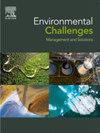Assessing spatio-temporal dynamics of land degradation neutrality using Goggle Earth Engine in the Alawuha Watershed of North Wello Zone, Ethiopia
Q2 Environmental Science
引用次数: 0
Abstract
Land Degradation Neutrality (LDN) aims to maintain or enhance land resources and is assessed using three indicators: land cover change, land productivity dynamics, and soil organic carbon (SOC). This study analyzed LDN dynamics in Alawuha Watershed, Ethiopia, using remote sensing data of these indicators within Google Earth Engine (GEE) platform to identify areas requiring intervention. The study used Landsat 5 TM and 8 OLI imagery (2000–2023) for land use/land cover (LULC) change analysis with the Random Forest algorithm, MODIS Net primary productivity (NPP) data (2001–2023) for land productivity, and gridded SOC data to map SOC distribution. The spatial distribution of NPP trends was analyzed using the Theil-Sen slope estimator in GEE, and the modified Mann-Kendall (MK) trend test in RStudio was applied to analyze mean annual NPP trends. The "one out, all out" principle was used to evaluate the overall LDN status. Results revealed an increase in forest cover (+1.95 % annually) and built-up areas (+11.77 % annually) from 2000 to 2023, while farmland declined at an annual rate of −1.23 %, mainly due to urbanization. The spatial distribution of the NPP trends showed productivity gains in the western and southern regions (+35.85 gC/m²/year) but declines in the northeastern region (−10.99 gC/m²/year) and lower SOC, signaling localized degradation. The MK test confirmed a significant increase in mean annual NPP (tau = 0.3913, p = 0.00078) at (α=0.05), with a Sen’s slope of 7.51 gC/m²/year, showing overall productivity improvement. These findings support LDN targets and provide insights for sustainable land management and restoration policies.
利用Goggle Earth Engine评估埃塞俄比亚北韦洛区Alawuha流域土地退化中性的时空动态
土地退化中性(LDN)旨在维持或改善土地资源,并使用三个指标进行评估:土地覆盖变化、土地生产力动态和土壤有机碳(SOC)。本研究利用谷歌Earth Engine (GEE)平台中这些指标的遥感数据,分析了埃塞俄比亚Alawuha流域的LDN动态,以确定需要干预的区域。利用随机森林算法分析土地利用/土地覆盖(LULC)变化,利用MODIS净初级生产力(NPP)数据(2001-2023)分析土地生产力,利用网格化土壤有机碳数据绘制土壤有机碳分布图。利用GEE中的Theil-Sen斜率估计分析NPP趋势的空间分布,利用RStudio中改进的Mann-Kendall (MK)趋势检验分析NPP年平均趋势。采用“一出全出”原则评价LDN的总体状态。结果表明:2000 ~ 2023年,森林覆盖面积和建成区面积分别增加(年均+ 1.95%)和11.77%,耕地面积减少(年均- 1.23%),主要原因是城市化。NPP趋势的空间分布表现为西部和南部地区生产力增加(+35.85 gC/m²/年),东北部地区生产力下降(- 10.99 gC/m²/年),有机碳含量降低,表明局域退化。MK检验证实,平均年NPP (tau = 0.3913, p = 0.00078)在(α=0.05)显著增加,Sen斜率为7.51 gC/m²/年,显示整体生产力提高。这些发现支持了LDN目标,并为可持续土地管理和恢复政策提供了见解。
本文章由计算机程序翻译,如有差异,请以英文原文为准。
求助全文
约1分钟内获得全文
求助全文
来源期刊

Environmental Challenges
Environmental Science-Environmental Engineering
CiteScore
8.00
自引率
0.00%
发文量
249
审稿时长
8 weeks
 求助内容:
求助内容: 应助结果提醒方式:
应助结果提醒方式:


